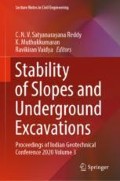Abstract
The great Himalayan Mountain is a majestic cluster of several numbers of more or less parallel hill ranges intervened by numerous valleys and extended plateaus. The Himalayan landscape, as said by expert geologists, is especially susceptible to landslides. The northward movement of the Indian plates caused continuous stresses on the hill slopes making them weak and prone to landslides. The Himalayan topography, as well as high seismic vulnerability and rainfall in the region, are enlarging the liability to landslides. Landslides or landslips involve a large ground movement due to the gravity forces, which result in total mass wasting of the slope. The landslides are experienced in almost all the national and state highways adjacent to the hill slopes of the Himalayas and hill ranges of India North East, Western Ghats and Nilgiris, Eastern Ghats, Himachal, J&K, Garhwal and Kumaon hill ranges, and Vindhyas. The remedial measures for landslides may be divided into four subcategories; restraint, removal, drainage, and relocation. The retaining structures are designed to retain rock/soil slope that would not naturally be stable at its position. The reinforcement measures include soil nailing and earth reinforcement measures, which involve the insertion of steel rods, metallic strips, geosynthetics, and steel angles to improve the stability of the slope. The reinforcement measures also include the improvement of the mechanical characteristics of the ground through chemical, thermal, or mechanical treatment. The third major remedial measures are drainage measures, which are most effective in a geologic condition that allows interference with the natural water regime. Also, bioengineering techniques in which vegetation is a fundamental part are useful approaches to prevent landslides as they improve slope stability and maintain ecological balance. They are most suitable to be deployed in developing countries because of their cost-effectiveness and environmentally friendly nature. The chosen remedial measures depend upon several factors such as type movement (slide, flow, etc.), type of material (debris, rock, soil, etc.), location of the failure, the process of failures, etc. The several factors that are to be considered before designing and implementing landslides remedial measures will be discussed in the paper. The paper shall be dealt with different sets of remediations such as soil nailing technique, earth reinforced structures, retaining structures, drainage measures, and bioengineering techniques for mitigation of landslides adjacent to roads in Himalayan terrain considering the economic as well as social feasibility, steadiness, and efficiency. Moreover, several advantages and disadvantages of remediation techniques shall be incorporated in the paper.
Access this chapter
Tax calculation will be finalised at checkout
Purchases are for personal use only
References
Bang, S., Shen, C.K., Romsted, K.M.: Analysis of an earth reinforcing system for deep excavation. Transportation Research Record, No. 749, pp. 21–26 (1980)
Cornoforth D.H.: Landslides in practice. In: Earth Reinforcement Systems, Chapter 20, pp. 424–441 (2005)
Sabahit, N., Madhav, M.R., Basudhar, P.K.: Seismic analysis of nailed soil slopes. In: Proceedings of IS Kyushu International Symposium on Earth Reinforcement, Kyushu, Japan, pp. 347–352 (1996)
Arya, A.S., Gupta, V.P.: Retaining wall for hill roads. I.R.C J. 44–1 (1983)
Lammeranner, W., Rauch, H.P., Laaha, G.: Implementation and monitoring of soil bioengineering measures at a landslide in the Middle Mountains of Nepal. Plant Soil 278(1–2), 159–170 (2005)
Raut, R., Gudmestad, O.T.: Int. J. Des. Nat. Ecodyn. 12(4), 418–427 (2017)
Author information
Authors and Affiliations
Editor information
Editors and Affiliations
Rights and permissions
Copyright information
© 2022 The Author(s), under exclusive license to Springer Nature Singapore Pte Ltd.
About this paper
Cite this paper
Panigrahi, R.K. (2022). Different Sets of Remediation for Mitigation of Landslides in Hilly Terrains of India. In: Satyanarayana Reddy, C.N.V., Muthukkumaran, K., Vaidya, R. (eds) Stability of Slopes and Underground Excavations. Lecture Notes in Civil Engineering, vol 185. Springer, Singapore. https://doi.org/10.1007/978-981-16-5601-9_13
Download citation
DOI: https://doi.org/10.1007/978-981-16-5601-9_13
Published:
Publisher Name: Springer, Singapore
Print ISBN: 978-981-16-5600-2
Online ISBN: 978-981-16-5601-9
eBook Packages: EngineeringEngineering (R0)

